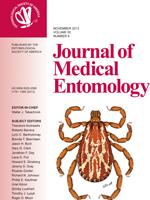This article describes morphological characteristics and the occurrence of Demodex gracilentus sp. nov., which was found in the striped field mouse Apodemus agrarius (Pallas, 1771) in the skin of vibrissae area. D. gracilentus occurred in 36.7% of the rodents examined. D. gracilentus is a relatively large representative of the genus (adult stages on average 292 µm in length), a slender, elongated body; characteristic feature of these mites are conical supracoxal spines on dorsal side of gnathosoma, palps with asymmetric, forked triple spines on palptarsus, and the presence of rhomboidal opisthosomal organ. So far, the occurrence of three specific representatives of the family Demodecidae has been demonstrated in A. agrarius: Demodex apodemi (Hirst, 1918) (=Demodex arvicolae apodemi Hirst, 1918), Demodex agrarii Bukva, 1994, and Demodex huttereri Mertens, Lukoschus et Nutting, 1983. The first one is related to common hair follicles, especially in the skin of the head, while the next one inhabits the external auditory meatus, and the last one occurs in the meibomian glands of the eyelids.
How to translate text using browser tools
1 December 2013
A New Species of Demodex (Acari: Demodecidae) with Data onTopical Specificity and Topography of Demodectic Mites in the Striped Field Mouse Apodemus agrarius (Rodentia: Muridae)
Joanna N. Izdebska,
Leszek Rolbiecki
ACCESS THE FULL ARTICLE
It is not available for individual sale.
This article is only available to subscribers.
It is not available for individual sale.
It is not available for individual sale.

Journal of Medical Entomology
Vol. 50 • No. 6
November 2013
Vol. 50 • No. 6
November 2013
Apodemus agrarius
Demodecidae
Demodex gracitentus
skin mite
topical specificity




